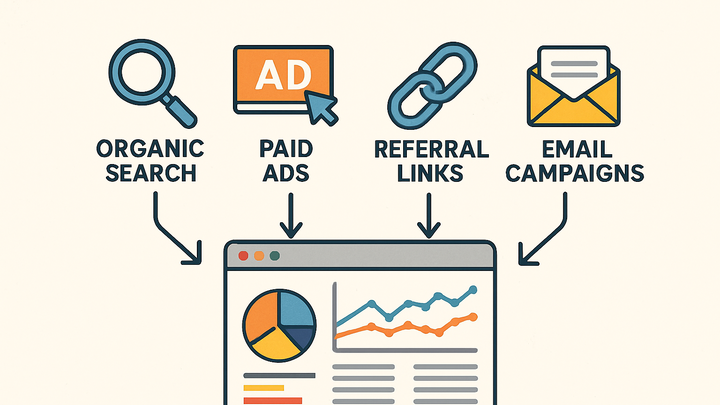Published on 2025-06-28T07:12:02Z
What is Medium in Analytics? Examples from GA4 and PlainSignal
In web analytics, Medium refers to the general category of a source that drives traffic
to your website. It is a key dimension in advertising and marketing analytics that helps categorize and
segment incoming traffic based on how users arrive at your site. For example, common media include
organic (search engine results), referral (links from other websites),
cpc (cost-per-click paid campaigns), and email (newsletter links).
Accurately tagging and understanding mediums allows marketers to measure campaign performance, optimize channel strategies, and allocate budgets effectively. Understanding mediums also improves cross-channel attribution and aids in crafting more targeted marketing campaigns. This glossary entry explores the definition of Medium, why it matters, how to track it in tools like Google Analytics 4 (GA4) and PlainSignal (cookie-free analytics), best practices, and common pitfalls.
Medium
Medium categorizes traffic by channel type (organic, referral, cpc, email), vital for segmenting sources and optimizing campaigns.
Definition and Role of Medium in Analytics
The Medium dimension classifies the general category of traffic sources that bring users to
your website. It provides context beyond specific source domains by grouping similar acquisition methods.
Understanding medium helps marketers compare performance across channels, such as differentiating unpaid
search from paid campaigns or email from social referrals. This categorization underpins accurate reporting
and informed decision-making.
-
Standard medium values
Most analytics platforms recognize a set of predefined mediums:
organic: Unpaid search trafficreferral: Links from other websitescpc: Paid search or cost-per-click campaignsemail: Traffic from email marketingsocial: Visits from social media platforms
-
Custom medium values
Beyond defaults, you can define custom mediums via UTM tagging or platform settings, such as
affiliate,partner, orsms. Custom mediums should follow a consistent naming convention to avoid data fragmentation.
Why Medium Matters
Medium is critical for evaluating channel performance and allocating marketing resources effectively. By analyzing mediums, teams can:
-
Segmentation
Break down user behavior and conversions by channel category to tailor strategies for each medium.
-
Attribution
Assign credit to the appropriate channels in multi-touch and last-click attribution models.
-
Reporting clarity
Keep reports consistent and understandable by standardizing how traffic sources are grouped.
Tracking Medium with SaaS Tools
Implementing proper tracking ensures Medium data is captured and interpreted correctly. Below are examples for Google Analytics 4 (GA4) and PlainSignal.
-
GA4 implementation
GA4 automatically reads UTM parameters to populate the
mediumfield. To tag campaigns:- Append UTM parameters to your URLs, e.g.,
?utm_source=google&utm_medium=cpc&utm_campaign=spring_sale. - GA4 will attribute visits to the specified medium.
In the GA4 UI, navigate to Reports > Acquisition > Traffic acquisition and select the Session medium dimension.
-
Utm parameters
Use
utm_mediumin your campaign URLs to define the medium. Stick to lowercase and hyphens for consistency. -
Viewing medium in reports
In GA4, filter or tabulate by Session medium to analyze performance across mediums.
- Append UTM parameters to your URLs, e.g.,
-
PlainSignal implementation
PlainSignal captures medium from UTM parameters with a lightweight, cookie-free script. Add the following to your HTML before the closing
</head>tag to start tracking:<link rel="preconnect" href="//eu.plainsignal.com/" crossorigin /> <script defer data-do="yourwebsitedomain.com" data-id="0GQV1xmtzQQ" data-api="//eu.plainsignal.com" src="//cdn.plainsignal.com/plainsignal-min.js"></script>-
Integrating the tracking snippet
Place the snippet before
</head>to ensure accurate data collection without impacting page load. -
Analyzing medium data
Use the default acquisition report in PlainSignal and filter by
mediumto assess channel performance.
-
Best Practices for Managing Medium
Maintaining consistent, clear medium tagging prevents data fragmentation and improves reporting accuracy.
-
Consistent utm tagging
Develop internal guidelines for naming mediums (e.g., use
cpcnotppc) and stick to them across all campaigns. -
Leverage standard definitions
Use platform-recognized mediums when possible to benefit from built-in reports and avoid custom configuration burdens.
-
Audit regularly
Periodically review acquisition data for unexpected or misspelled mediums and correct tagging issues promptly.
Common Pitfalls
Errors in medium setup can skew analytics and lead to poor decision-making. Watch out for:
-
Missing medium tags
Forgetting to append
utm_mediumto campaign URLs results in traffic being bucketed under(not set). -
Typographical errors
Inconsistent spelling or case (e.g.,
CPCvs.cpc) creates multiple medium buckets and complicates analysis. -
Overuse of custom mediums
Creating too many custom mediums can fragment your data and make cross-channel comparisons difficult.
